The Adventurer’s Guide To Wing Walking In 2024
The Adventurer’s Guide To Wing Walking In 2024
This is an accompanying piece to my story about That Time I Walked The Wing Of Moving Plane. It provides a deeper look into the training sequence involved to get started with wing walking at the Mason Wing Walking Academy in Sequim, Washington. If you haven’t already, read that first to get my take on the whole and come back here for all the more in-depth details.
The Origin Of Wing Walking On A Bi-Plane
Not long after the Wright Brothers invented the airplane did the entrepreneurial minds of the time began concocting up plans to entertain the masses while promoting flying and airplanes in general. Daring pilots began performing aerial stunts across the countries, one-upping each other, for fame and a bit of fortune. Eventually, it got to the point where the stunts involved the pilot themselves and not just the plane.
The story goes that a U.S. Army Air Service pilot named Ormer Locklear would walk onto the wings of his plane during training to fix mechanical issues mid-air without having to land. He would later go on to be one of the first daredevil to perform stunts to the public as part of the “barnstorming” aerial show movement of the 1920s. He would also eventually meet his end during a wing walking stunt.
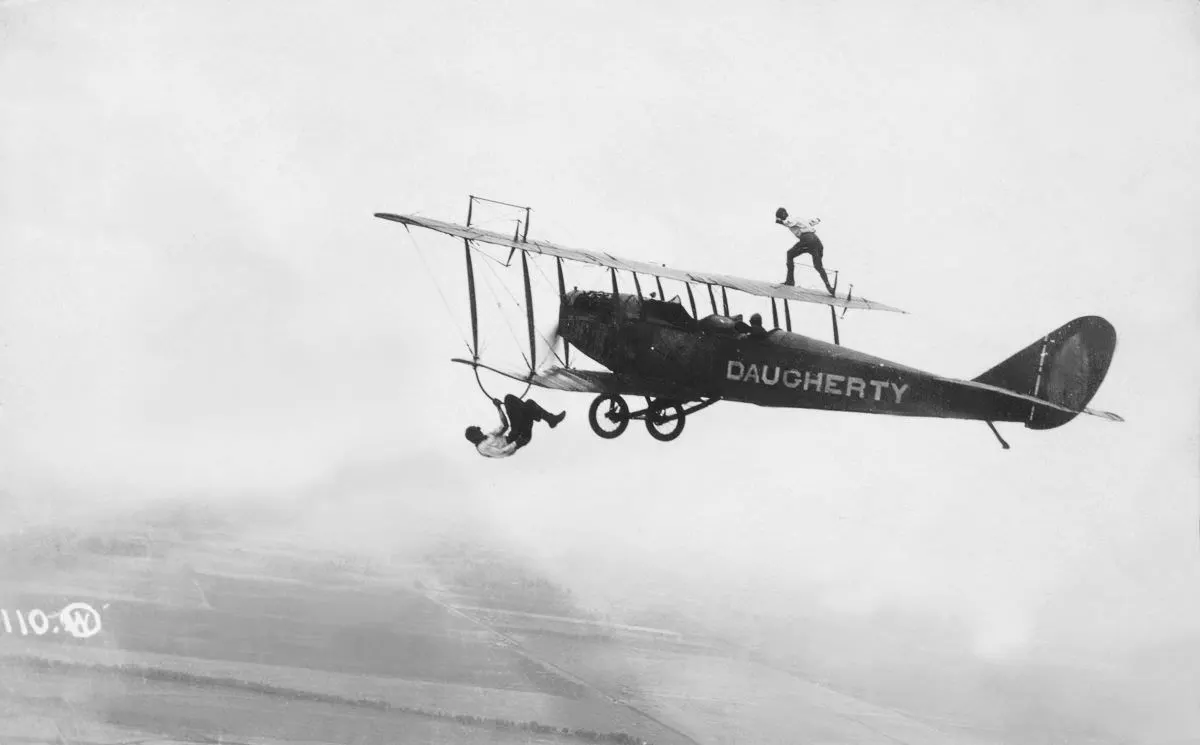
From a practical standpoint, wing walkers were also used to perform mid-air refueling for the U.S. Air Corps, walking with a fuel pack from one plane to another to refuel and allow for longer distance flights. And then it was mostly forgotten about by the public. In 2020, there’s a small, but dedicated global community who still perform the walks. Most of them doing it privately, but there are a few places where someone like me, or you, can go and experience wing walking for themselves.
Where To Go Wing Walking In the US
As far as I know, the only place where anyone can learn to wing walk in the United States is at the Mason Wing Walking Academy in Sequim, WA. This is where I went and it’s actually the only place in the world where you can just show up and learn to do a full proper wing walk. I say full and proper because you do have a couple of other options if you happen to be in the United Kingdom.
Where To Go Wing Walking In The UK
The UK has a number of different companies that offer a wing walking experience, but it’s not exactly the same thing as what I did at the Mason Academy. AeroSuperbatics offers what I would call a wing-riding experience in multiple locations around England. The Wing Walk Company offers a similar experience. You are strapped into a backrest on the top wing before taking off and you stay there the entire time. It’s still one of the most exhilarating experiences and aimed at a much broader crowd because you don’t have to do anything yourself. At around £399, it’s half the price of the training course and walk at the Mason Wing Walking Academy.
How Much Does It Cost To Wing Walk?
At the time of this writing, it’s $1250 for a full day course at the Mason Academy that includes learning to walk on the upper and lower wing and $850 for a half day course that only includes the top wing. They both include photos and videos that are provided by the Masons. Most of the photos you see were taken from their cameras.
If you plan on doing this and can afford it, I highly recommend doing the full course. This is really a once in a lifetime experience (although I’ve been told that there are people who return year after year to do it again) and you want to get the full experience. It’s worth every dollar, because there is nothing quite like it on offer as far as I know.
In the UK, the wing riding experience generally start at £399. The cheapest place to go wing walking in the UK is with the Wing Walk Company that offers a weekday ride for £350 with another £30 for HD videos.
Wing Walker Training
For all the obvious reasons, you simply do not just wing walk. While the training is not complicated, it is absolutely necessary, so you can safely get out of the cockpit and maneuver your way around the airplane without hurting yourself or damaging the plane. Yes, you can easily damage the plane and you don’t want to do that. The 450 Stearman is a thing of beauty. It’s a plane from the WWII era and has been meticulously restored and maintained to keep it in perfect flying conditions.
As part of the wing walker package, you begin your day at the Mason Wing Walking Academy meeting with and going through movements on the ground with Marilyn Mason. Along with her husband, Mike Mason, they run the academy and offer this unique experience to the public.
Top Wing Movements
Before you take to the air, you start with a visualization exercise and walk through every part of the flight in your head starting with getting into the cockpit. Get in, buckle up and picture the take-off. 4000 feet up, you get a plane wag from Mike signaling you to look at the rear view mirror to get a confirmation to climb up.
You unbuckle yourself from the seat belt and then re-buckle it to prevent the belt from flying around during the aerobatics part. Slide up from my seat, grab the left overhead hold and then the right overhead hold. Next you stand up and place the back part of left foot on the back of my seat and the rest of it on the side of the plane. Place your right hand to the center bar of the wing rack, step up and plant your right foot on the front of Mike’s cockpit window rest. Breathe.
From here, you move your left hand forward to the front cable, push up from my right leg to get your left foot onto the original left overhead hold and slide forward. Twisting your body to the left makes it easier to bring your right leg up to the top wing.
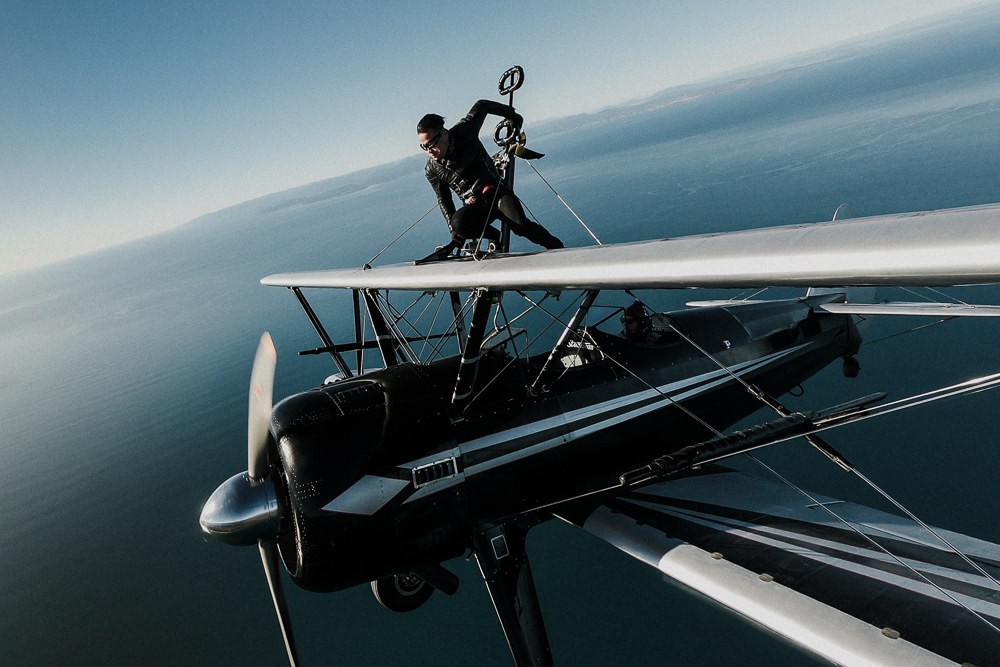
Here, you slide the right foot into the left foothold and shimmy up with part of my back against the rack, before transferring your right foot over to the right foothold. Now you can stand up completely and move your left foot into the left foothold. Use this moment to collect yourself before releasing any cable holds to reach behind you for the waist belt hardness. Again, breathe.
Buckling In
With the belt behind you, you blindly feel for the latch, unclip, and bring the belt to my front of your waist and clip in. Tight the right side, tighten the left side and double check both the latch and the tightness of the straps a second time before you give the thumbs up to Mike to indicate that you are secured and ready for the aerobatics. Breathe.
It sounds more complicated than it really was. Essentially, the moves are designed so you can almost instinctively and gracefully move into position while feeling as secured as possible. By the 4th time doing this on the actual plane, I pulled it off with my eyes closed (just in case something happened with my contacts) and only by feel. In a pinch, I wouldn’t have hesitated to do the upper wing only by feel. That’s how comfortable I felt after the training.
After the series of aerobatics, Mike would level out and you can enjoy the flight for a few minutes before he wags the plane to signal the climb back down. The moves would be done almost in reverse with a few small exceptions.
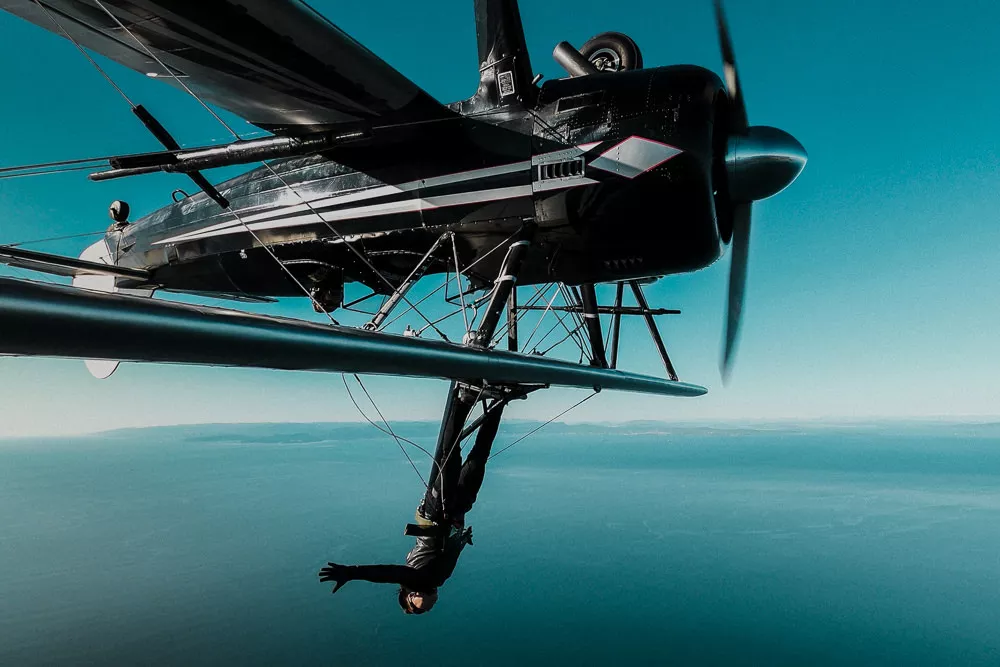
Lower Wing Movements
For the lower wing, you will make your way to a suspended padded bar called a “javelin” in a horizontal lay flat position. Think Harry Potter during the Quidditch tournament on a broomstick. Once again, you train with every hand and foot movement planned out.
After takeoff, the plane wags and you do the unbuckle/re-buckle sequence. Then put your right hand on the left overhead hand hold and slide up onto the seat. Your left hand should also find one of the wing cross bars for support. Step over with your left leg onto the wing while being mindful of the areas on the wing that’s not solid.
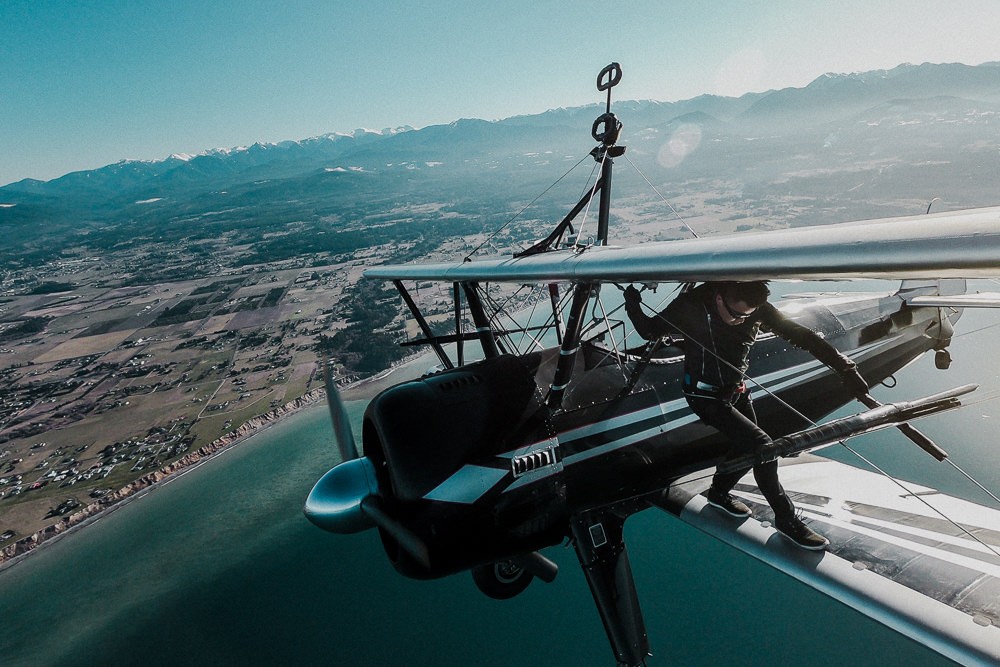
And there was that. The wing is mostly a lightweight frame wrapped with fabric. You can’t just step where you want. Along the front of the wing, there are marked spots that have ribbed support. These are designated spots where you are allowed to put your weigh on during the walk. Marilyn warned me that with the force of the 60 mph winds, it will be harder than I expect to try to place my feet on those small spots. Hard, but very doable.
Like Riding A Broomstick
So, left leg over, find your footing, and then swing your right leg and the rest of your body over. Place your left hand to the top of the cross bar cable and your right foot right up to the bottom of another cross bar cable, effectively locking yourself down with a foothold. Get the right hand to a parallel cable, and then the first step onto the 2nd of the marked spots with your left foot, and then step onto the 4th spot with your right foot. Turn your body slightly to the right and swing you left leg over the javelin careful to place the left foot onto the 6th marked spot. Plant it down and then move your right foot to the 5th spot.
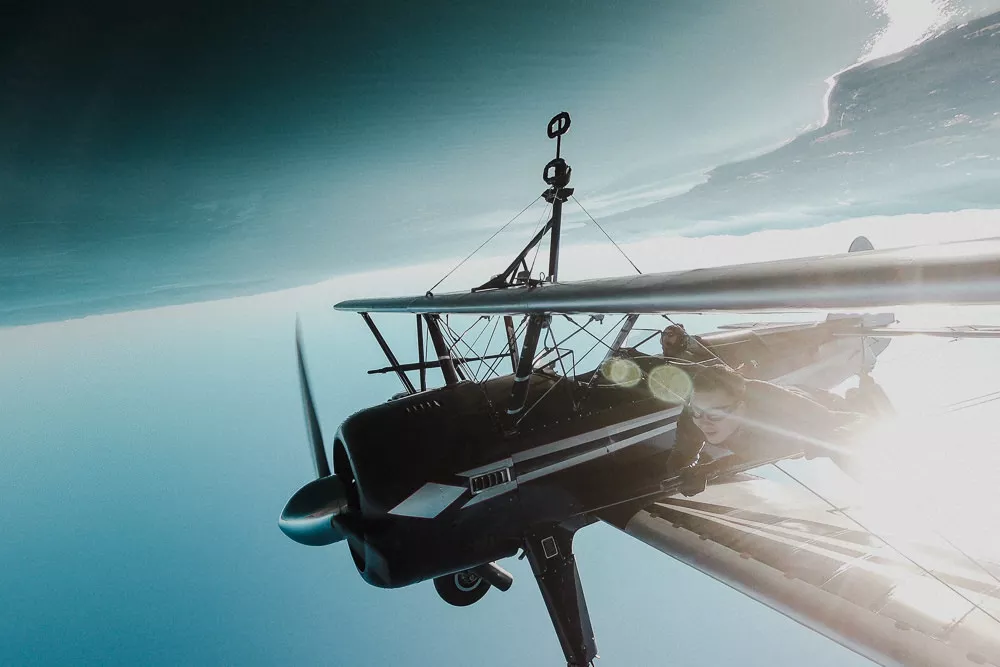
From here, lean forward with your torso on the bar, and bring your leg back to the cross cables and onto the back of the javelin, repeating with the right leg and placing it over the achilles of your leg foot. You can then find any hold that is comfortable for you in this horizontal position and give the thumbs up for Mike to do the aerobatics.
Throughout this, Marilyn kept reminding me to not forget to relax and look at the camera too. I love it. Picture or it didn’t happen right? Don’t forget to relax. It does not help to be tense during the flight.
Safety Training
After a lunch break, you continue the training, but with the safety line attached. This “lifeline” is a braided cable attached to one of the cross bars of the wings. It’s clipped to the waist harness you wear and provides a back-up option in case you fall.
Training with the hardness on wasn’t that different. You just need to keep it out of the way to avoid entangling with you. With the help of the wind, the cable is usually blown away from your body, so it never got it in the way for me like I expected it to do. Instead, I complete forget about it for the 95% of the flight.
So what was wing walking actually like? If you haven’t already read it, go check out That Time I Walked On The Wing Of A Moving Plane.
Best Time To Go Wing Walking
Reach out to the Masons at Mason Wing Walking Academy to get latest info on whether they are flying at a particular time of the year. I flew in March in a tight window that somehow ended up with perfect weather. Usually, they start flying later in the springtime when there’s lower precipitation in the lush Pacific Northwest. I was dressed with a couple of base layers and a leather jacket and benefitted from the warmer than usual weather that week. Had it been colder, it wouldn’t have been as enjoyable after the first few minutes.
June, August, and September are the best months in Sequim, so those are the recommended times to go wing walking, but there are regularly people who try to “cherry pick” a weekend here and there during other times of the year. Check in with the Masons if you are planning a trip to the area and just want to add this into your itinerary.
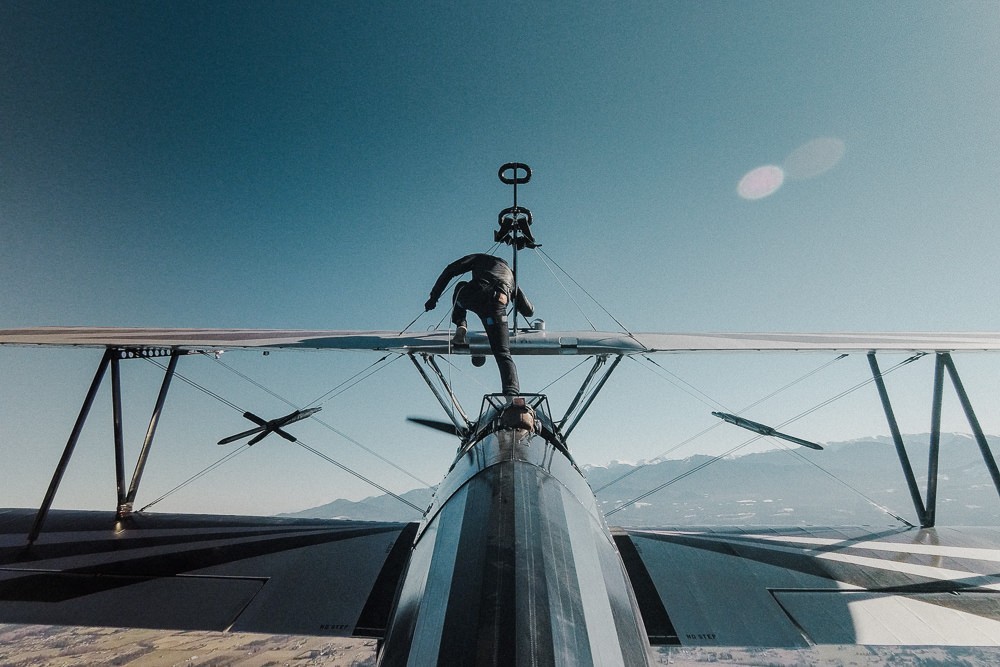
Is It Safe To Wing Walk On A Plane?
The idea of risk and safety is all relative. I know it’s not a straightforward answer, but I don’t consider myself an adrenaline junkie or a huge risk-taker. Risks evaluations are involved in most things I do, and while it’s possible that I could slip and off and dangle on a cable from an old 1940s era biplane, I considered it a low probability as long as I followed the training instructions and gave it my complete focus.
I feel safe climbing around a jungle gym and this is basically the same thing, but the idea that you are doing it in the air with some wind makes it more daunting that it is really is. I’m not trying to downplay it, but I really think that it’s 90% mental and 10% physical. As long as you can do it on the ground, you can do it in the air. It’s merely the idea of it that keeps most people from entertaining the possibility of doing something like this. I honestly find so many other things we do in our day to day lives much more of a risk than something like this.
So, be brave, embrace the curiosities of life, and consider putting this on your Bucket List.
Looking for more travel inspirations? Scroll through some of the 450+ experiences on my bucket list. Maybe you’ll find your next adventure on there.
How You Can Help
If you’ve found the content useful, you can help support this site by using these links when you plan and book your trip.
| Booking.com | Agoda.com |
| Amazon.com | Klook.com |
| Viator.com | GetYourGuide.com |






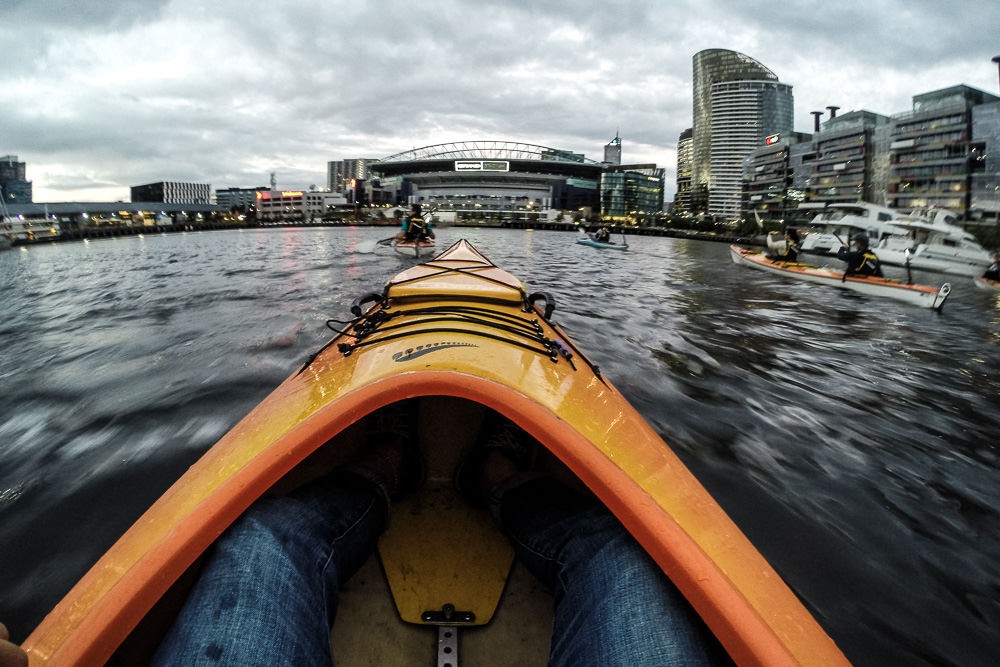
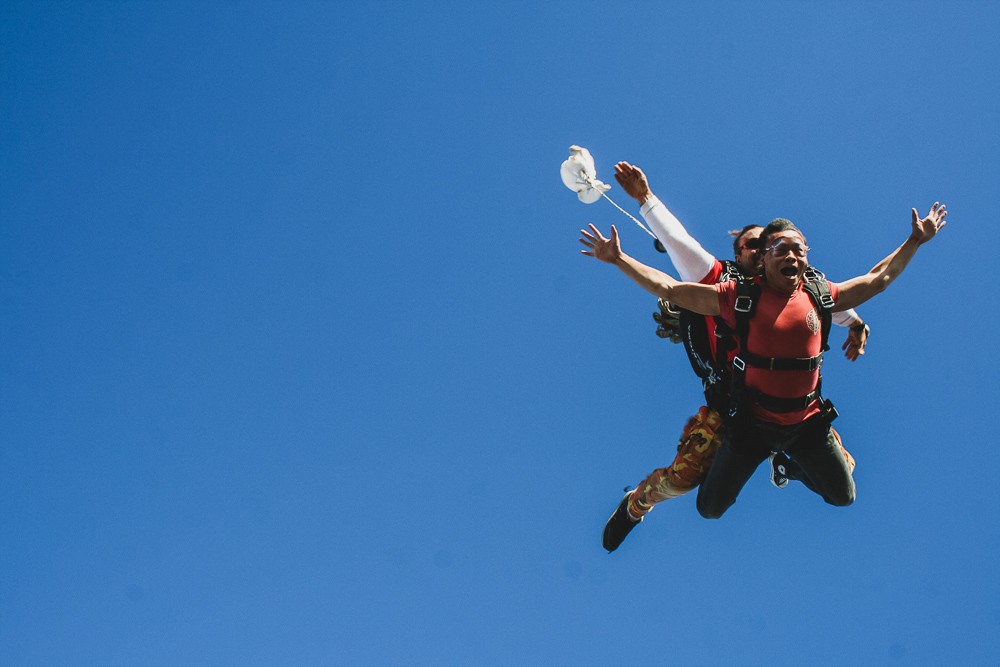

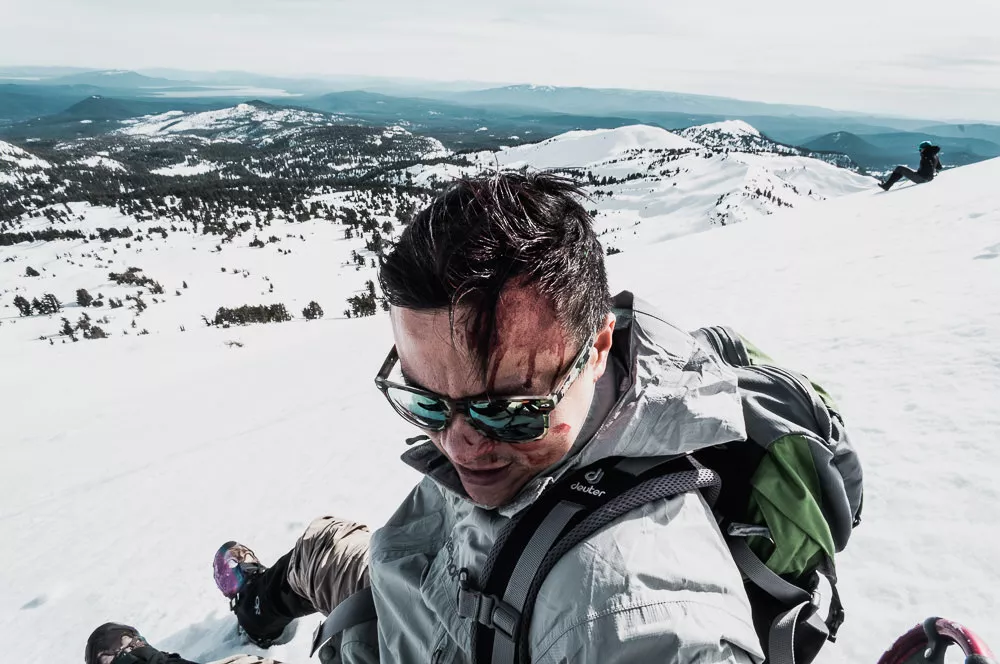

[…] lead-up to the actual experience. I’ve also created a companion piece going in depth into the training and how you try out wing walking for yourself. You can find a link at the bottom of the story as […]
Very cool video doing that this weekend! Your website is beautiful and very fast, you rock~!
That’s so cool. Have the best time in the air and say hi to the Masons for me.
Hi all I don’t believe I have actually signed up to do a wing walk on the 21st june , in aid of east cheshire Hospice. Heights are not a strong point for me but I am sure I will be in good hands and it is all for a great cause wish me luck !!! .
So awesome Joanne! Have a blast and savor every moment up there. If you are doing it with the Masons. Tell them I said hi!